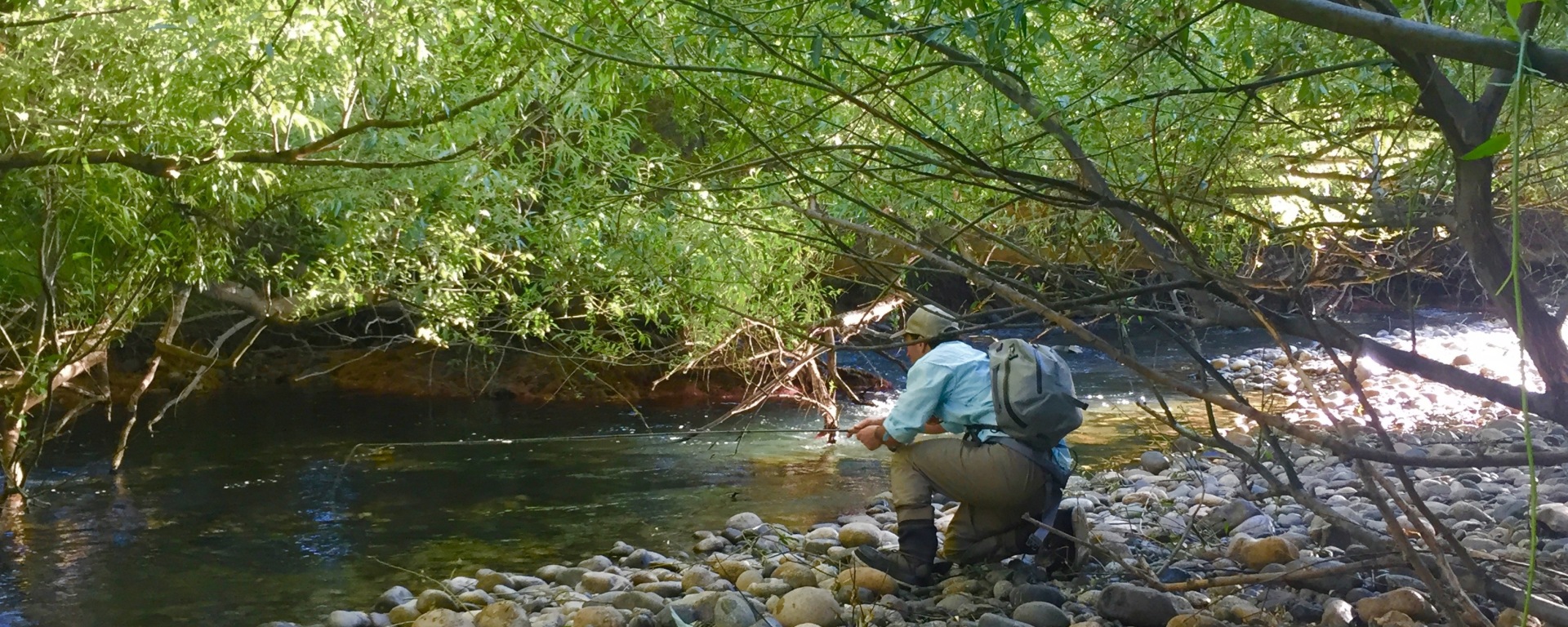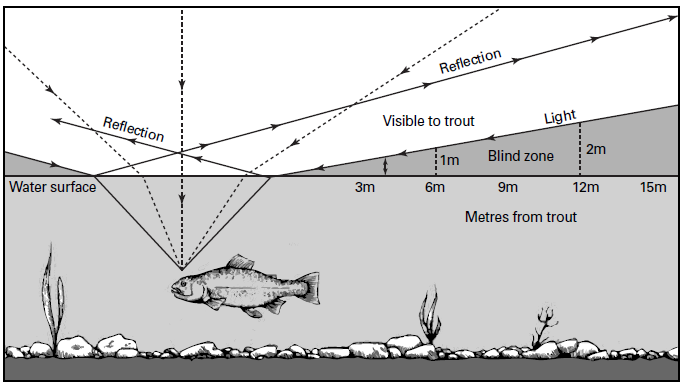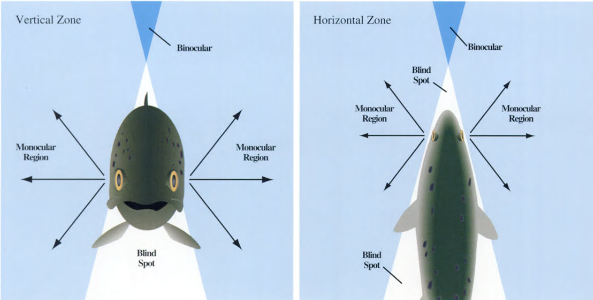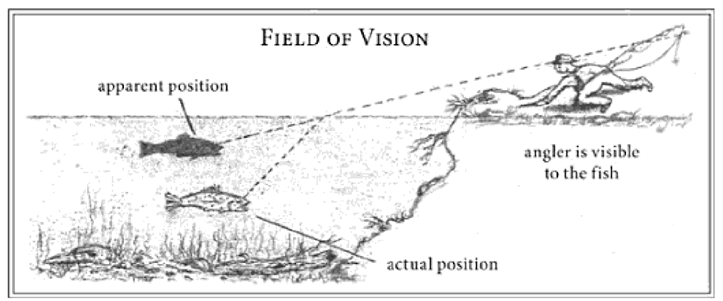In order to successfully stalk fish it is important to have an appreciation of what fish can actually see. This is determined by several things, where their eyes are positioned on their head, water clarity and how deep in the water they are holding. There are some fundamental rules of physics which help understand what a fish can see and it is really useful to understand these when stalking.
A fish has a cone shaped range of vision that is defined by a circular window on the surface of the water (called Snell’s window). As a rough guide the circular window is twice as wide as the fish is deep. For example, if a fish is holding one metre deep then the circular window will be two metres in diameter. If it is holding two metres deep then the window will be four metres in diameter. Outside of the window the fish sees nothing above the water and the surface around the window from below either appears black or like a mirror. Whether it is black or mirror like depends on the angle at which the light rays are reflected. If they are reflected back along the surface it is black and if they are reflected down by total internal reflection then the surface appears mirror like. This is shown in the image above.
When stalking it is important to remember that the fish’s peripheral vision around the perimeter of the Snell’s window extends quite low to the horizon. As you can see from the image above the closer you get to the fish the more chance there is of being spotted. As a rough rule of thumb someone of average height can probably approach to within 10 metres of a fish without being spotted. Crouch low and you can probably get within 5 metres. It is also worth noting that images at the edge of Snell’s window become distorted due to the severe refraction. This means that by keeping a low profile there is less chance of being recognised as a predator, even if the fish detects your shape.
Another point worth recognising is that the deeper the fish sits the bigger the cone directly above it and the more it can see along the bank. In the diagram above the solid line is for deep fish and the dotted for shallow. This means that you should be more careful when approaching fish holding on the bottom when nymphing than to fish that are rising to take flies from the surface and holding close to it.
A fish with eyes positioned at the side of the head has a wide field of vision. This is because it has both binocular and monocular vision. When both eyes are used to see in front and above it is classed as binocular vision and when only one eye is used to see to each side of the fish it is monocular. The binocular fields are typically 30 – 36 degrees wide whereas the monocular field is 150 degrees on both sides of the head. This is shown in the image above. Note that there are a couple of blind spots directly in front of the snout, behind and underneath the fish. If your fly or lure passes underneath the fish or lands too close to it and passes over the fishes head before sinking to eye level then it will likely be ignored.
If a fish sees the fly or lure in the binocular zone then it will be able to perceive depth and detail most accurately and mostly it aligns itself so that it can intercept a food item using both eyes. Presenting the fly or lure in the binocular zone well ahead of where a fish is holding is generally going to give the best chance of success. This gives the fish time to spot the fly, align its fins to rise and intercept it and drop back down to where it is holding with minimal energy expenditure. Having said that, sometimes it may not be a good strategy to do this. If the area you are fishing receives a lot of angling pressure then it may occasionally pay to present the offering inside the monocular zone so that the fish can only use one eye to gauge authenticity and take the fly out of instinct.
When stalking it is important to approach the fish from directly behind or low to the horizon to take advantage of its blind spots.
Another thing which many anglers forget is that the apparent position of a fish in the water is not the actual position (See above). This is because light “bends” (refracts) when it travels at an angle into water as air and water have different optical densities. This change in direction is caused by the light slowing down as it enters the water. If you are looking down into the water at an angle of 45 degrees then typically the light bends downwards by around 13 degrees when light passes from air to water. This means that the fish is actually holding deeper and slightly closer than it actually looks. Perhaps this is why sighted fish sometimes do not seem interested in a fly or lure? It may well be that the angler is delivering the offering too high in the water column and it is either landing in the blind spot or passing too high above the fish for it to make a smooth, controlled ascent to intercept it. If in doubt, cast further upstream.
There are a few other basic rules which build on the physical principles above and help improve stalking success. In essence the aim is to get yourself into a position from which you are not visible to the fish, can see as much water as possible while all the while making sure that you do not create any unnatural movement or colour on the bank which might scare the fish. The rules are:-
- Wear dull-coloured or camouflage clothing. Browns, greys and greens are good because they match the colours generally found on the banks of rivers and lakes. The basic aim is to wear clothing that is indistinguishable from the surrounding backdrop.
- Always move as slowly and carefully as possible. One of the things that will reveal your presence on the bank most obviously is movement. Fish are extremely sensitive to movement. Apart from the natural swaying of trees in the wind, and the natural movement of birds and other wildlife, fish are used to everything on the bank being totally motionless. So as soon as fish detect some kind of unnatural movement, it suspects that danger has arrived. Therefore, whether you are walking alongside a river, flat or skirting around the edge of a lake, always make sure that you slow your pace down as much as you can. Try to move carefully and tread lightly. If a fish appears from nowhere then freeze.
- Always seek cover. Constantly be on the lookout for natural objects on the bank to hide behind. Trees and large bushes provide excellent cover, as do big rocks. It is a good idea to find cover and stay concealed for a few minutes watching the water to see what is happening. it is surprising how often a fish will show itself as it cruises along a feeding beat.
- When you see a fish, stop and observe for a while. Don’t rush in! This is very important. As a colleague once said “time spend in reconnaissance is seldom wasted”. Analyse the situation before you start to cast to the fish. Determine where it is holding and whether it is necessary to put on a different fly. The fish may be drifting around the pool in the river, or back and forth along the section of the lake shore or flat where you’ve been stalking making it necessary to wait until the fish is in exactly the right position before beginning to cast.
- Watch your shadow. Always be aware where your shadow is being projected, especially when the sun is behind you. Try to keep your shadow as far away from the fish as possible.
- Avoid wearing shiny objects. The flash of light reflected from shiny objects can alert fish to your presence. Try to minimise the amount of highly reflective surfaces and stay in the shade.






Great article!
Very thought out and insightful piece.
Thanks for the kind words Tim.